Day 3 of a three day Autumn Tour in Norfolk today, our last day. The weather forecast for today kept changing, from heavy rain and gales when we looked two days ago, with people worrying we would not be able to get out, to sunshine and showers as of yesterday, and now rain for the morning before brightening up. The winds were forecast to pick up in the afternoon, but to nothing like what had been predicted earlier in the week. Once again, the multi-million pound Met Office supercomputer was struggling to make up its mind!
With the possibility of rain this morning, we decided to head over to Titchwell, where we could at least get into the hides. While some of the group were packing up, we popped down to see if the Wryneck was still present. It had been seen at dawn, but we couldn’t find it in a quick look and then it started to rain. Having had a great view yesterday, we decided not to hang around.
When we got to Titchwell, it wasn’t raining so we walked round to the overflow car park to see if there were any birds in there. It looked fairly quiet at first, but waiting patiently we began to see a few Blackcaps in the bushes, with two together feeding on elderberries. A tit flock flew across and disappeared through into the back of the thick hedge by the entrance road. We could hear a Goldcrest calling with them, but the birds were hard to see here and quickly headed off back along the hedge.
There were lots of finches in the trees too. We had a quick scan from the gates at the end which didn’t produce anything of note out in the paddocks, but we did find a couple of Song Thrushes in the bushes by the coach park.
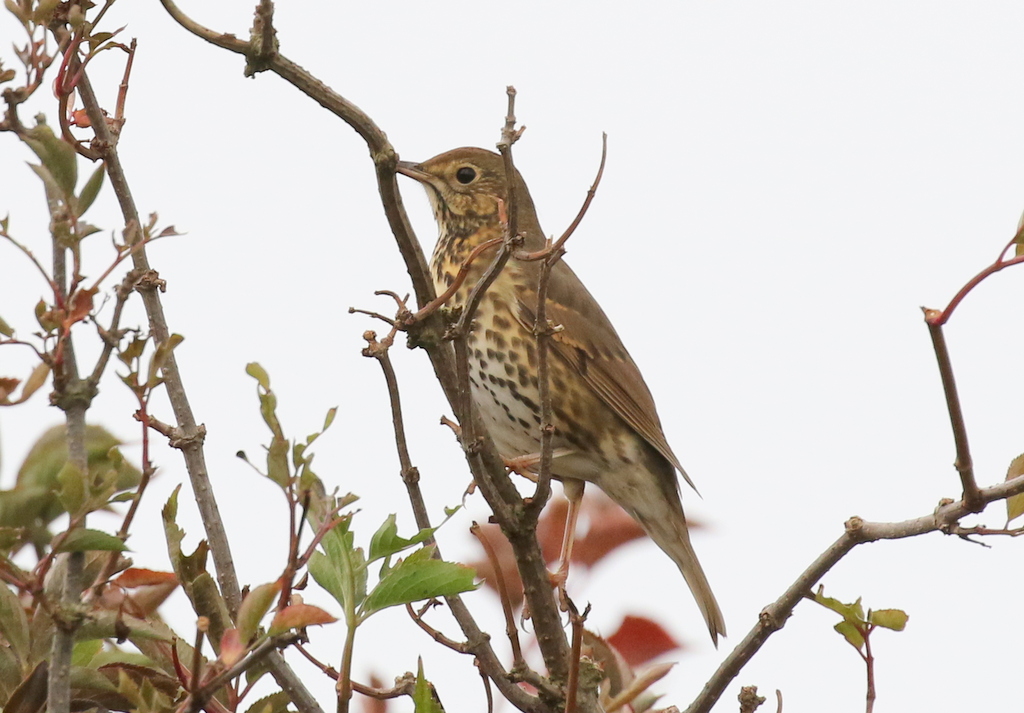
The feeders by the Visitor Centre had just a few finches and Blue Tits on them this morning, but as we set off along Fen Trail there were one or two Chiffchaffs in the sallows and we quickly came across another mixed tit flock. A Great Spotted Woodpecker flew over our heads, calling. As we got out of the trees, past Fen Hide, it started to spit with rain again.
Carrying on to Patsy’s Reedbed, we could see a Marsh Harrier up over the reedbed beyond as we approached, hanging in the wind. There were lots of ducks out on the water again – a nice selection of Gadwall, Mallard, Teal, one or two Shoveler, several Common Pochard and a single eclipse drake Pintail – but we couldn’t see the Red-crested Pochard on here today.
It was not a morning to stand around in one place too long, as we headed off along to the Autumn Trail. We could hear another Chiffchaff calling in the hedge as we passed and a Water Rail was squealing from deep in the reeds at the far side of Patsy’s Reedbed. At the start of the Autumn Trail, we heard the pinging of Bearded Tits. Scanning carefully, we managed to find a male climbing up into the top of the reeds. We got it in the scope, and most of the group managed to get a quick look at it before it flew again.
It was low tide now and there were not many birds roosting on the back of the Freshmarsh when we got to the end of the trail. There were lots of Teal down on the mud and we could see several Avocets feeding, up to their bellies in the deeper water. We could hear more Bearded Tits here and had a couple of quick views of one or two flicking up out of the reeds before a male flew across and landed briefly on the edge of the cut area just in front of the viewpoint.
The rain eased off again, but it was still feeling rather damp, so we decided to head round to the hides. We cut across on Meadow Trail to the main path and walked up past the reedbed. As we got to the reeds by the old Thornham grazing meadow ‘pool’, which is getting increasingly overgrown, we could hear yet more Bearded Tits calling. Once again, we had a couple of brief views of a male in the reeds, before it flew back into the reeds along the path behind us. They really were very active today – even though it was cool and damp, at least the wind hadn’t really picked up yet.
The reedbed pool held just a couple of Little Grebes and three Coot, all over towards the back. But two Sand Martins swooping back and forth low over the water were the first we had seen this weekend and a welcome addition to the list. We headed on quickly to Island Hide.
There didn’t seem to be so many waders on the Freshmarsh today, with fewer Black-tailed Godwits in particular, and it appeared that there had been a clear-out of smaller waders too. Still there were plenty of birds to see here. In particular, no shortage of Ruff still, in a variety of colours and sizes, paler winter adults and browner juveniles in different shades, bigger males and much smaller females. We had a nice view of a winter adult male and a juvenile female on the mud right in front of the hide.
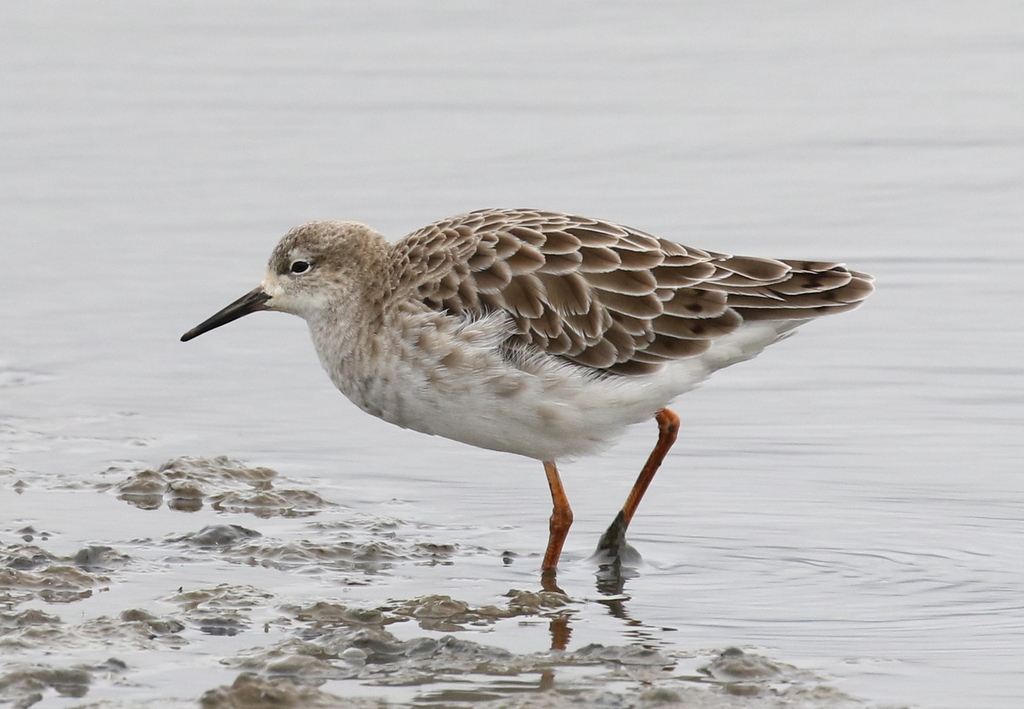
We managed to find one lone Dunlin. Then a Ringed Plover dropped in on one of the muddy islands and was quickly joined by two more Dunlin.
The ducks on here were mainly Wigeon and Teal, with the drakes still mostly in their dull eclipse plumage so not looking their best. Looking carefully through the Teal, we managed to find the Garganey which has been seen here on and off over the last week or so. Even though it was a long way back, the Garganey’s more contrasting face pattern really stood out compared to the Teal around it.
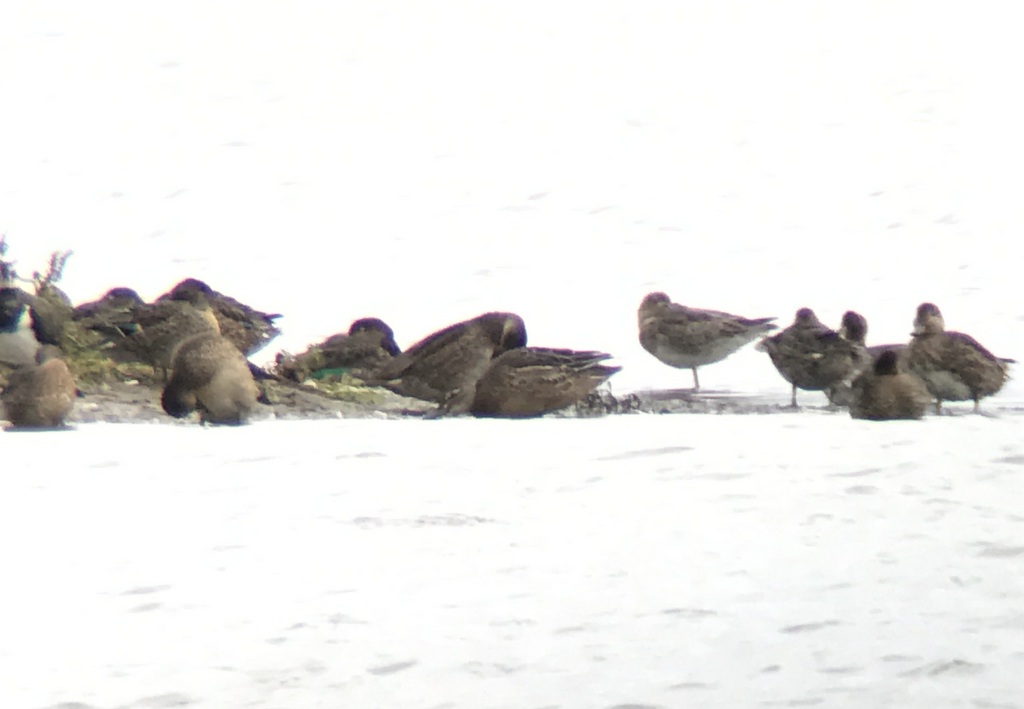
There have been two Pink-footed Geese on the Freshmarsh all summer. They are both injured birds, with badly damaged wings, unable to fly back with the others to Iceland for the breeding season. They came over to bathe in the muddy channel right in front of Island Hide today. We got a really good view of their bill patterns, close up, but we could also really appreciate just how mangled their wings are as they flapped and preened.
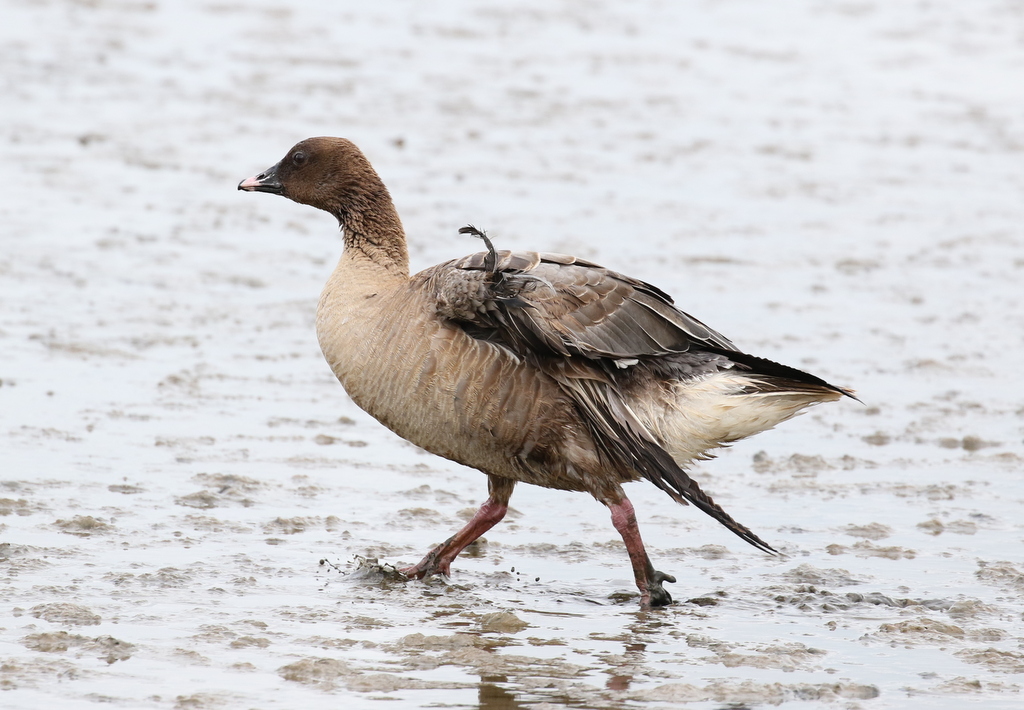
The wind was starting to pick up a bit now and reports were coming through of good numbers of interesting skuas, shearwaters and petrels passing by offshore all along the coast. When the north wind blows at this time of year, the best birds are to be found out to sea. It was really a day for seawatching today, but that is not a suitable pastime for the faint-hearted! We did look up to see two Great Skuas, or Bonxies as they are known, flying past over the volunteer marsh just behind Parrinder Hide. They looked big and dark apart from their bold white wing flashes.
There were a few gulls on the Freshmarsh today, mainly Black-headed Gulls but with a few Lesser Black-backed Gulls and Herring Gulls with them too. One gull stood out amongst the Black-headed Gulls – it was a touch bulkier and heavier billed, with a black mask, paler overall and with less black in the wing tip. It was a second winter Mediterranean Gull. We had a look at it in the scope and when we looked back a couple of minutes later, it was joined by a second Mediterranean Gull, this time a first winter.

One of the group picked up four Spoonbills coming in high over the reedbed. They looked for a minute like they might come in to land on the Freshmarsh, half circling, having a look at their usual roosting spot at the back, before carrying on over the bank and disappearing away towards Brancaster. The Spoonbills tend to spend most of their time feeding out on the saltmarsh over low tide and then coming in to roost at high tide, which was not until much later this afternoon.
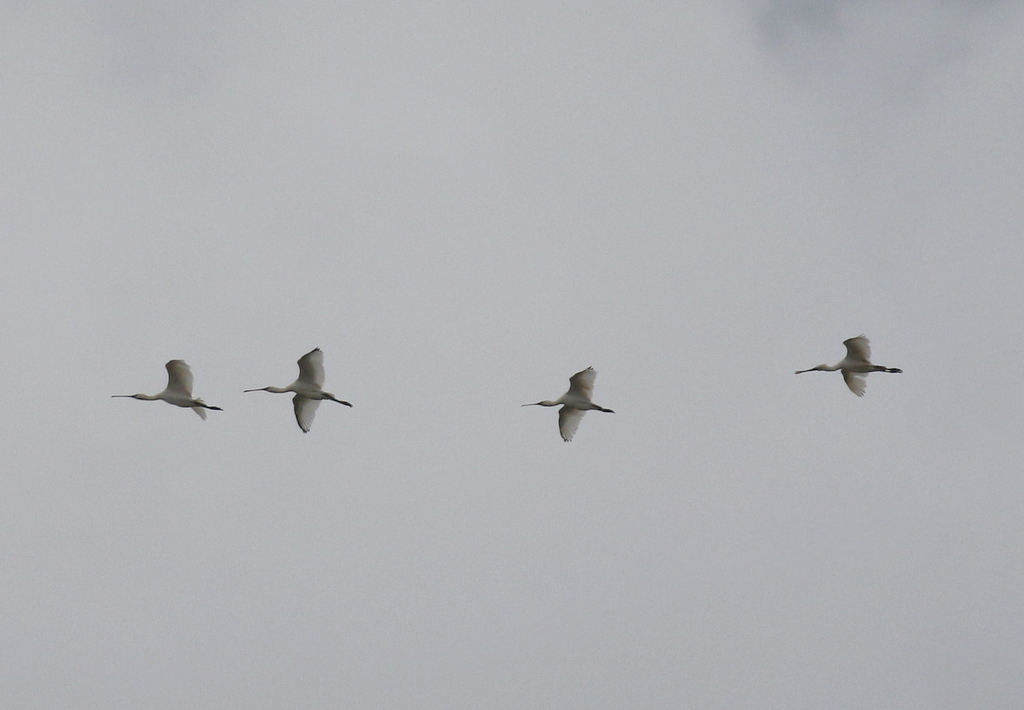
We could hear Bearded Tits calling from not far away so scanned along the base of the reeds opposite the hide. Two Bearded Tits were feeding on the mud in the sparse reeds along the near edge, an adult male and a juvenile. They weaved their way in and out and spent several minutes feeding here giving us a great opportunity to get a really good long look at them through the scope. Always great birds to see like this!
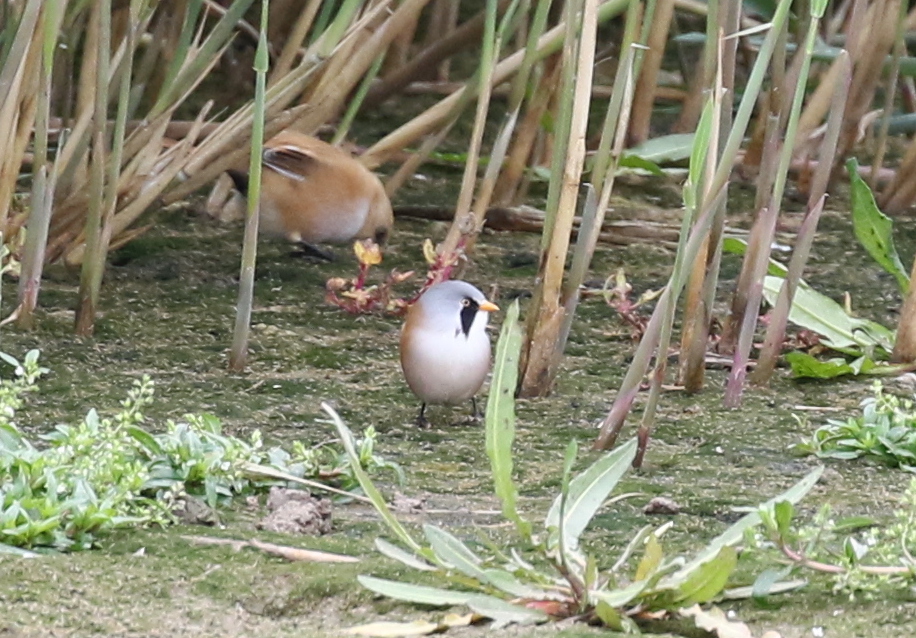
Nearby, we noticed some movement in the weedy vegetation out on the mud and looked across to see the head of a Common Snipe stick up. It was very well hidden in here, but did eventually come out so we could see it properly.
It was getting on for lunch time now and we wanted to at least try to have a good look out to sea, so it made more sense to head back to the Visitor Centre for a break now, and then come out again afterwards. We could already see a band of brighter sky away to the north, and over lunch the sky cleared and the sun even came out!
After lunch, we walked back out past the Freshmarsh. There were not many birds on the Volunteer Marsh, not even on either side of the muddy channel at the far end, although we did stop to admire a couple of Common Redshanks down just below the main path. In the bright sunshine now, their legs were shining day-glo orange!
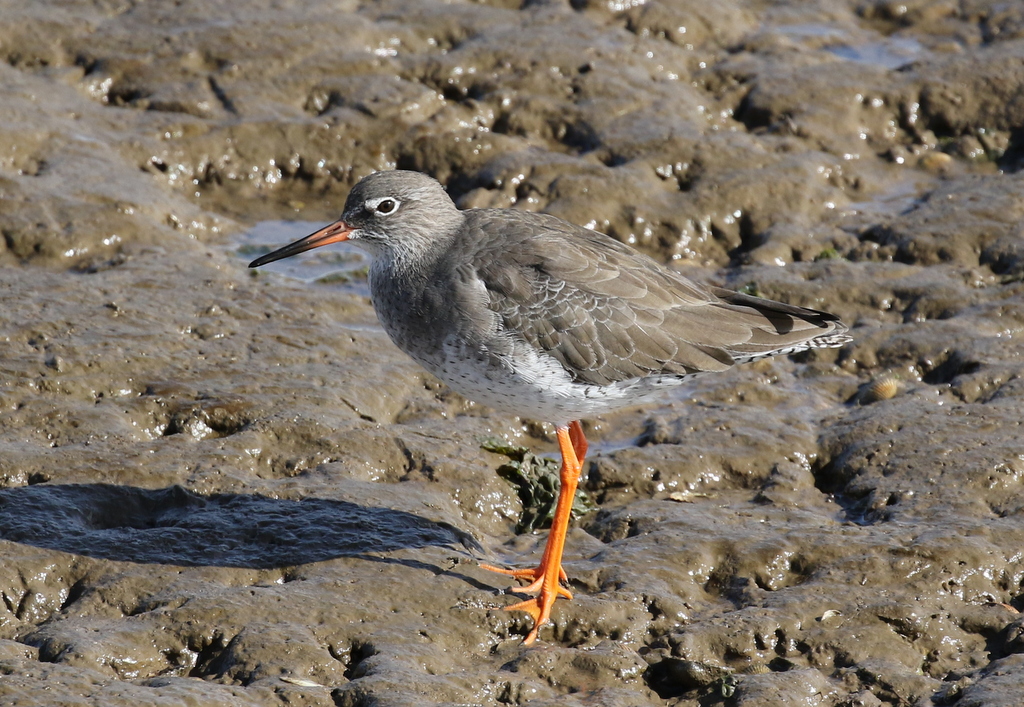
The non-tidal Tidal Pools are now very full with water. We could see a few waders hunkered down on the one remaining grassy island, but there were not many on here now. When we got out to the beach we could see why – they were all gathered out on the mussel beds.
There is not much shelter from the wind at Titchwell, but we tried to have a scan of the sea from the dunes. One of the first birds we picked up was a Manx Shearwater just offshore. It was heading west, but turned and came back past, alternately arcing up into the sky and skimming down over the waves, flashing black and white as it turned. There were several small groups of Arctic Skuas flying past a bit further out and one or two young Gannets.
Although there were patches of blue sky, there were some squally showers coming in off the sea too in the increasingly fresh north wind. We sheltered from one brief one behind the dunes and then made our way down the beach for a closer look through the waders. Despite the fact that it was not long after low tide, the mussel beds were covered quickly by the tide, the sea pushed in quickly by the wind.
We could see lots of Black-tailed Godwits out on the shoreline, accompanied by a good number of smaller Knot. Several Bar-tailed Godwits were walking about on the wetter sand higher up the beach and a Grey Plover, still sporting the remnants of its black underparts from breeding plumage was on the drier sand closer still. A large flock of Turnstones took off and flew in up the beach and as the tide rose, the godwits and Knot started to fly off too.
It wasn’t quite so windy here, further down the beach, so we tried to have another quick look out to sea. A line of six Arctic Skuas came past, quite close in, one of them a smart pale adult. Unfortunately we were not all kitted out for an extended seawatching session on the beach in these conditions, so when another shower came in off the sea, we headed back.

There were more waders along the muddy channel on Volunteer Marsh now, bolstered by the birds coming in off the beach. There were several Curlew, more Redshanks and Black-tailed Godwits. One Black-tailed Godwit walked down to feed on the mud just below the main path, giving us a great close-up view as it probed for worms.
We stopped in at Parrinder Hide on the way back. There were more waders on here too now, in particular a large flock of Bar-tailed Godwits which had come in from the beach to roost. Through the scope, we could see that several were still sporting the remnants of their rusty breeding plumage, and there were a few grey winter Knot hiding in with them. A small flock of Golden Plover flew in and circled round, their golden brown upperparts catching the sun, before landing on the islands.

On the way back to the car, we heard a Whimbrel calling out over the saltmarsh in the distance and more Bearded Tits calling in the reeds. A couple of flocks of Pink-footed Geese flew high overhead calling, presumably more returning birds back from Iceland for the winter.
We made our way back along the coast road to Wells. It would be a bit more sheltered from the increasingly blustery north wind in the woods, so we figured we would spend the last hour of the afternoon in here. There have not been very many unusual migrants coming in recently with the persistent westerly airflow, but with the Wryneck appearing yesterday anything is possible. It was worth a go.
There were several Little Grebes on the boating lake and a couple of Tufted Ducks. But as we got into the trees it all seemed rather quiet, apart from a couple of Jays squawking. We had a quick walk round the Dell and then through to the Drinking Pool. We were surprised by the number of Chiffchaffs calling in the trees today, but we struggled to find a significant tit flock – presumably they were feeding somewhere in the pines this afternoon. When we got back past the Dell, we did find a couple of Long-tailed Tits in the bushes, but they seemed to be on their own.
It was time to call it a day now anyway, so we made our way back home. It had been a really exciting and varied three days, with some excellent birds – well worth coming out despite the dire weather predictions beforehand!
















